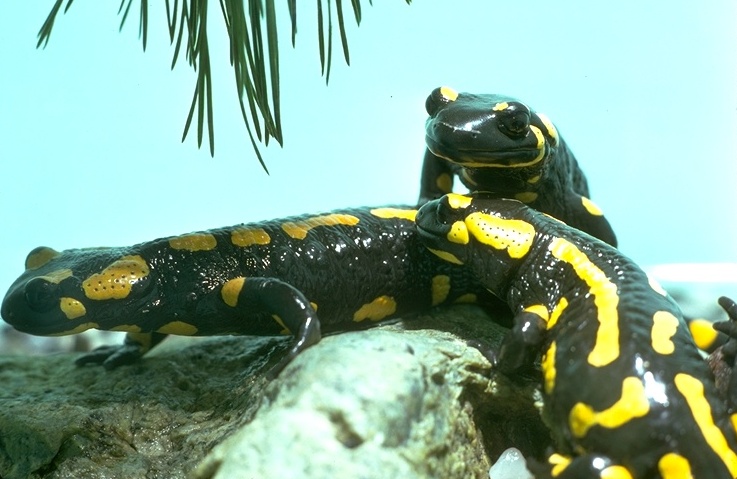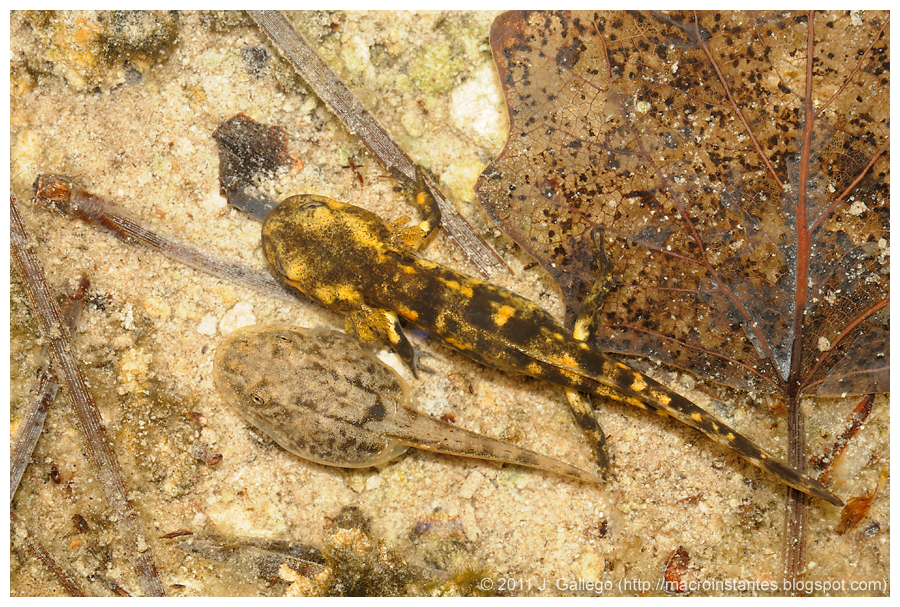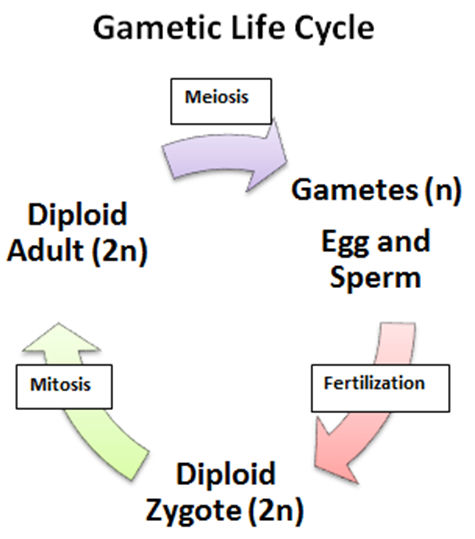Salamandra salamandra - Fire Salamander
Reproduction
Males vs. Females
It can be very challenging to determine the sex of a fire salamander, depending on the time of the year. During their mating season, the males will produce a sperm packet (swollen region on underside, near tail). Also, females are usually larger than males; however this sexual dimorphism is not great, as the average sizes of both males and females are relatively similar. The reason for females to be larger is that they would have a greater egg-carrying capacity.
Courtship and Mating
Mating most often occurs on land, beginning in spring and lasting
until autumn. The most common mating time is late spring and early
summer. However, depending on the location of the species, this
time frame may vary. For example, any species living in a warmer environment,
such as the Middle East, will instead mate between October and January.

Males with vivid coloration have a better chance at reproducing with a female. Once a male has detected a possible mate, he will confront her and block her path. The male will then rub the female's nose and proceed to crawl underneath her, so that she is on his back. While in this position, the male will rub the female's head with his chin and her cloaca with his tail. The cloaca is a cavity into which reproductive, urinary, and intestinal canals open to; this structure is seen in amphibians, birds, and fish. When the male is ready he will release his spermatophore; a small rigid packet of sperm. After the spermatophore is released, he will try to lower the female onto it, so that she may take it up through her cloaca. After she has received the spermatophore, the packet dissolves and the individual sperm cells are released. Fertilization occurs internally, and is followed by a long period of gestation. Gestation can last anywhere from 2-5 months, and usually takes place during hibernation.
Larvae/Metamorphosis
S. salamandra is ovoviviparus; meaning females carry their young in eggs within their body, and when it comes time for the eggs to hatch, they will do so within the uterus. Shortly after hatching, the female will find a small pond and give birth to 20-75 fully developed larvae. This birthing process can last anywhere from hours to a few days.
 The larvae that are born will live in the water for about 3-5 months.
While they are living in the aquatic environment, they possess external
gills through which they take in oxygen, until their lungs are
developed. This will occur during metamorphosis.
The larvae that are born will live in the water for about 3-5 months.
While they are living in the aquatic environment, they possess external
gills through which they take in oxygen, until their lungs are
developed. This will occur during metamorphosis.
Metamorphosis occurs in most amphibians, and it is the overall process of changing from an aquatic organism to a terrestrial organism. During salamander metamorphosis, skin will thicken, dermal glands will form, gills will be reduced and lungs will form in their place, limbs will lengthen, and the tongue, teeth, and eyelids will form. Fire salamanders will also reach sexual maturity at this point.
General Life Cycle
 To
the right, is a diagram I created indicating the basic gametic life cycle.
This diagram will also show the life cycle of a fire salamander, but in
more general terms. Beginning with a diploid adult, some of their
cells will undergo meiosis, creating their gametes (sex cells). In
animals, these gametes will be egg and sperm. During the mating
process as described above, the egg from a female and sperm from a male
will fuse during fertilization, forming a diploid zygote. The zygote
will continue to develop via mitosis, and an embryo will form. In
fire salamanders, embryos are held in eggs within the female's uterus.
Once they have developed enough, the eggs will hatch within the mother,
and many larvae will be born into an aquatic environment; where they
will continue to grow and develop until they themselves are mature
diploid adults. Here the process will begin again.
To
the right, is a diagram I created indicating the basic gametic life cycle.
This diagram will also show the life cycle of a fire salamander, but in
more general terms. Beginning with a diploid adult, some of their
cells will undergo meiosis, creating their gametes (sex cells). In
animals, these gametes will be egg and sperm. During the mating
process as described above, the egg from a female and sperm from a male
will fuse during fertilization, forming a diploid zygote. The zygote
will continue to develop via mitosis, and an embryo will form. In
fire salamanders, embryos are held in eggs within the female's uterus.
Once they have developed enough, the eggs will hatch within the mother,
and many larvae will be born into an aquatic environment; where they
will continue to grow and develop until they themselves are mature
diploid adults. Here the process will begin again.
Since we now know about the reproduction habits of Salamandra salamandra, let us check out their Interactions with other species.
Return to Nutrition or go to Home